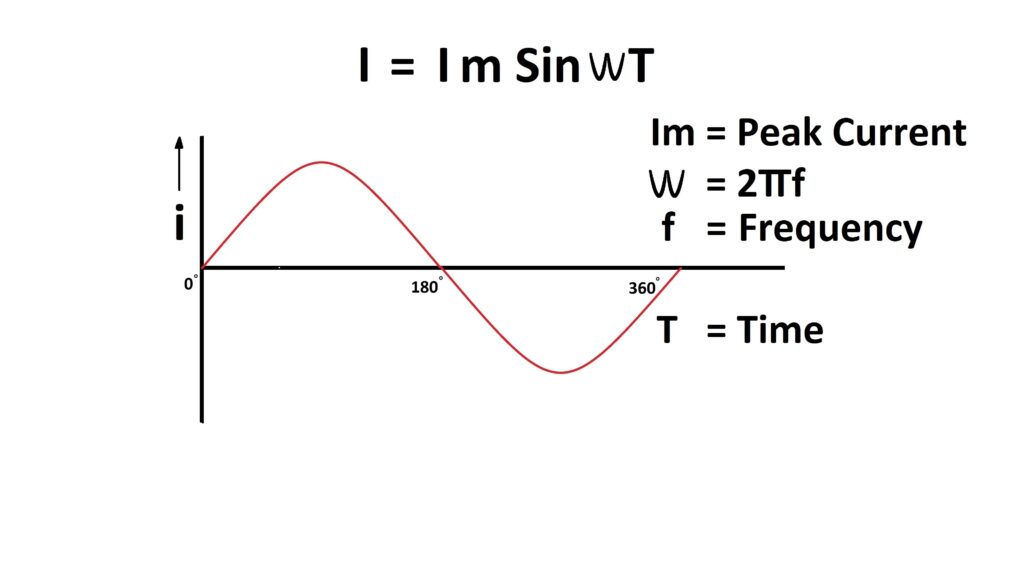

First, we are going to see the difference between Alternating Current and Direct Current.
Alternating Current is a type of electrical current, in which the direction of the flow of the electrons switches back and forth at a regular intervals or cycles. Direct Current is a type of electric current, in which electrons emerge from the negative pole and move towards the positive pole that is the flow of electrons is unidirectional and doesn’t switch back and forth.
Alternating current is represented by I(t)= Imsinωt
where ω is the angular frequency
ω =2πf,
where f is frequency i.e. number of oscillations per second.
In simple words, AC is not constant. It switches on and off continuously. It has sinusoidal behavior. It is maximum at a multiple of 90 degrees and zero at zero, or a multiple of 180 degrees as shown in the diagram.
That means our electric bulb switches on and off continuously, but since the
frequency of on and off is so high, it can’t be detected by the human eye.
Now,
let’s look at the behavior of direct current. Direct current has very simple
behavioral characteristics. In DC voltage and current remains constant with
time.
Why don’t we use electric power in the form of DC since DC is more stable than AC? The
reason is that AC power can be transmitted over a distance with less power loss which cannot be done in the case of DC. In AC voltage can be increased or decreased with the help of transformers.
So, once electricity is generated at generating stations, the voltage of the same
is raised for transmission over the long distance. And later voltage is again
reduced at a level suitable for usage.
As we know, Power is a vector multiplication of voltage and current, all being vector quantities, but to make it simple let’s consider the magnitude of all the quantities in the example.
So, Power = VxI, whereas V = Voltage, I = Current
Hence, Heat loss during power transmission = I²Rt,
t = Time for which power is being transmitted
This power loss occurs in the form of heat.
Power loss is proportional to the square of the current.
So if we increase voltage, the current value goes down for constant power. And
consequently, power loss goes down significantly.
Let’s take an example.
Consider that 100 MegaWatt power is to be transmitted.
Hence
P= 100×10⁶ Watt
So let’s consider the Voltage (V) = 10000 volts & Current (I) = 10000 Amperes.
Consider resistance of conductor (R) = 1 mili ohm and power is to be transmitted for 1 second.
Let’s analyze the case for DC first.
Power loss = I²Rt = (10000) ²x0.001×1 = 100000 watt = 100 kilowatt
In India, the generation voltage levels are 16.5 kV and 21 kV. But for Power transmission, 220 kV, 400 kV, and 765 kV are used. The maximum voltage at which AC power is transmitted in India is 765 kV. These different voltage levels are achieved using power
transformers.
If we consider, voltage is stepped up at around 20 times the generation voltage.
Hence for transmission of the same power, current will be reduced proportionally.
As in examples power P= 100×10⁶ Watt = VxI = 10000×10000 Watt
But in this case stepped-up voltage is 20 times generated voltage
V1= 20×10000=200000 Volts
Therefore new current value I1= 100 x10⁶/200x103volt = 500 Amperes
So, The new power loss = 500²x0.001×1 = 250Watt.
Just look at the difference between losses in AC and DC systems. It is 99.75 kilo watts.
Power loss is 100 kilo watts in DC, and just 250 watts in AC.
If we analyze further the difference in the loss is 400 times.
Or simply put we can say that, as we decrease the current 20 times by raising the voltage value. Power loss is inversely proportional to the square of the current. It reduces loss by 400 times that square of 20.
Therefore AC has the upper hand. That’s why it is very obvious and economic to use an AC power system.
Also nowadays HVDC technology has come, wherein we step up AC voltage, convert it into DC, transmit it and then again convert it into AC. This is done because DC does not have a reactive power component. But the capital and operating cost for HVDC technology are quite high. Hope you guys are clear now, why do we use AC predominantly in the world and not DC.